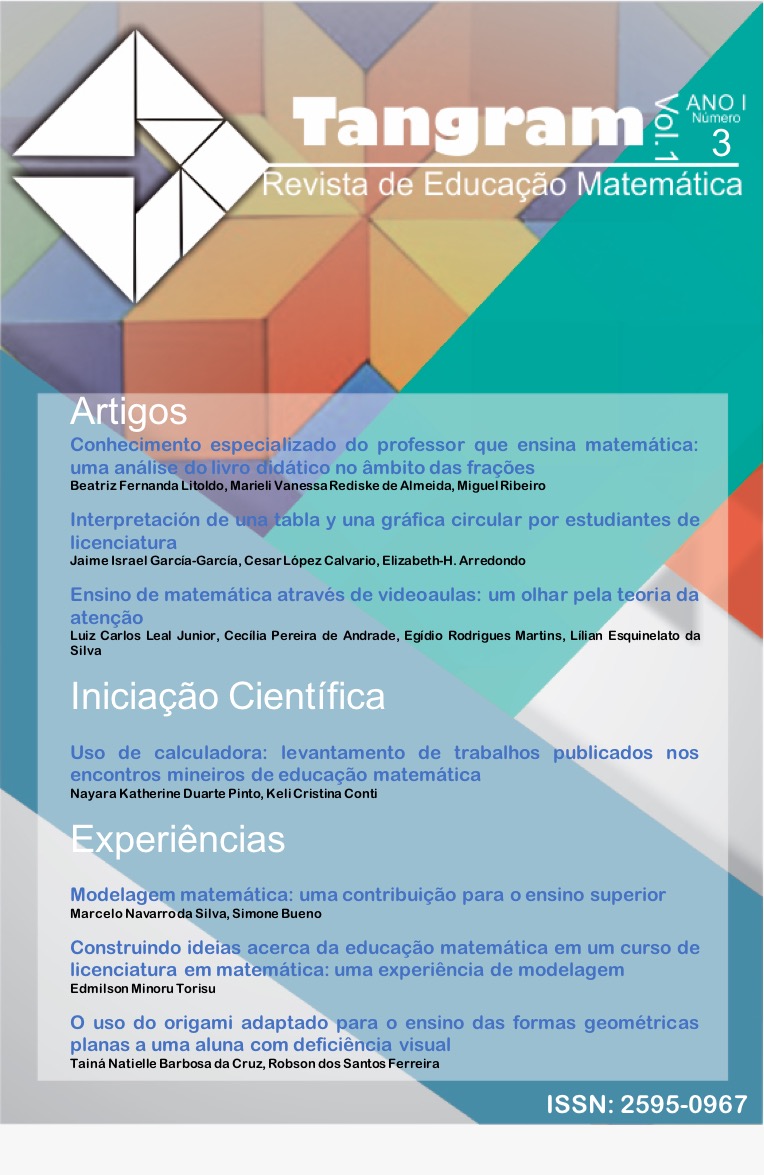O uso do origami adaptado para o ensino das formas geométricas planas a uma aluna com deficiência visual
DOI:
https://doi.org/10.30612/tangram.v1i3.8333Resumen
Neste artigo discutimos as potencialidades do origami no desenvolvimento de conceitos e de caracterização de figuras geométricas planas. As discussões aqui apresentadas fazem parte de uma experiência de ensino realizada durante o curso de licenciatura em matemática. Os resultados apontam para o potencial da utilização do origami no desenvolvimento de conceitos relacionados às figuras planas, tais como: número de lados e suas medidas, a ideia de lados opostos, lados paralelos, dentre outras. Notamos dificuldades nas formas de representação dos ângulos, o que indica a necessidade de desenvolver outras estratégias para se trabalhar essa representação com alunos cegos. Diante da necessidade cada vez maior de recursos metodológicos para o ensino de Geometria, especialmente para os alunos cegos, consideramos que as discussões fomentadas contribuem para o trabalho com conceitos geométricos voltados a alunos deficientes visuais, ainda na primeira etapa do ensino fundamental.
Descargas
Citas
Brasil. (1997). Parâmetros Curriculares Nacionais: Matemática. Ministério da Educação/Secretaria de Educação Fundamental. Brasília.
Brasil (2017). Base Nacional Comum Curricular. Ministério da Educação. Brasília.
Fernandes, S. H. A. A, Healy, L. (2016). Rumo à Educação Matemática Inclusiva: reflexões sobre nossa jornada. REnCiMa, Edição Especial: Educação Matemática, 7 (4), 28-48).
Descargas
Publicado
Cómo citar
Número
Sección
Licencia
Os autores devem aceitar as normas de publicação ao submeterem a revista, bem como, concordam com os seguintes termos:
(a) O Conselho Editorial se reserva ao direito de efetuar, nos originais, alterações da Língua portuguesa para se manter o padrão culto da língua, respeitando, porém, o estilo dos autores.
(b) Autores mantém os direitos autorais e concedem à revista o direito de primeira publicação, com o trabalho simultaneamente licenciado sob a Atribuição-NãoComercial-CompartilhaIgual 3.0 Brasil (CC BY-NC-SA 3.0 BR) que permite: Compartilhar — copiar e redistribuir o material em qualquer suporte ou formato e Adaptar — remixar, transformar, e criar a partir do material. A CC BY-NC-SA 3.0 BR considera os termos seguintes:
- Atribuição — Você deve dar o crédito apropriado, prover um link para a licença e indicar se mudanças foram feitas. Você deve fazê-lo em qualquer circunstância razoável, mas de nenhuma maneira que sugira que o licenciante apoia você ou o seu uso.
- NãoComercial — Você não pode usar o material para fins comerciais.
- CompartilhaIgual — Se você remixar, transformar, ou criar a partir do material, tem de distribuir as suas contribuições sob a mesma licença que o original.
- Sem restrições adicionais — Você não pode aplicar termos jurídicos ou medidas de caráter tecnológico que restrinjam legalmente outros de fazerem algo que a licença permita.






